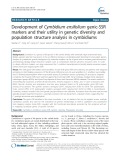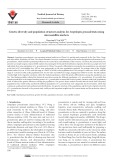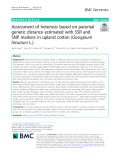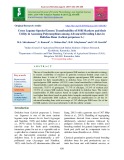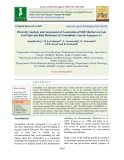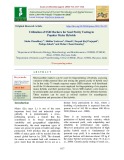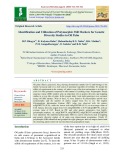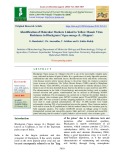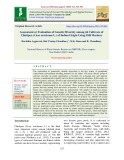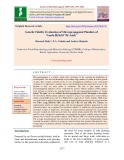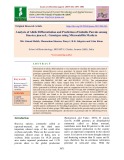
Utilization of SSR markers
-
Cymbidium is a genus of 68 species in the orchid family, with extremely high ornamental value. Marker-assisted selection has proven to be an effective strategy in accelerating plant breeding for many plant species.
 14p
14p  vinarcissa
vinarcissa
 21-03-2023
21-03-2023
 3
3
 1
1
 Download
Download
-
Ampelopsis grossedentata is an important national medicine in China. It is mainly used commonly by the Yao, Miao, Dong, and other ethnic minorities of China. The current literature, however, contains no study on the molecular genetics and taxonomy of A. grossedentata, which had led to potential problems in the conservation and utilization of this resource. Therefore, the present study was aimed to use simple sequence repeat (SSR) markers for assessing the levels and the distribution of genetic diversity in a sample set of 225 individuals from nine populations of A. grossedentata in China.
 13p
13p  lyhuyenthu
lyhuyenthu
 31-01-2023
31-01-2023
 3
3
 2
2
 Download
Download
-
Heterosis has been extensively utilized in different crops and made a significant contribution to global food security. Genetic distance (GD) is one of the valuable criteria for selecting parents in hybrid breeding.
 11p
11p  vilichoo2711
vilichoo2711
 23-06-2021
23-06-2021
 13
13
 1
1
 Download
Download
-
Hence it can be successfully deployed for selecting desirable genotypes which can be utilized in future breeding programs for exploiting heterosis or in the introgression of genes for biotic and abiotic stress tolerance in soybean crop.
 11p
11p  trinhthamhodang11
trinhthamhodang11
 27-04-2021
27-04-2021
 9
9
 2
2
 Download
Download
-
The use of transferable cross-species/genera SSR markers is an alternative strategy to ensure availability of markers in genomic resources-limited crops such as dolichos bean. A total of 275 cross legume species/genera SSR markers were examined for their transferability to dolichos bean.
 13p
13p  nguathienthan8
nguathienthan8
 20-10-2020
20-10-2020
 11
11
 1
1
 Download
Download
-
Samba Mahsuri is an elite, fine grain rice variety, which is grown extensively in India. To finger print and identify a genotype specific marker from 26 other closely related fine grain types, we utilized a 113 SSR markers distributed throughout the rice genome. Twenty six markers found to be polymorphic among the rice varieties analyzed. A twin marker combination RM 19426 +JGT 11-16.3 could unambiguously differentiate samba Mahsuri from other fine grain varieties through multiplex PCR.
 7p
7p  quenchua6
quenchua6
 15-06-2020
15-06-2020
 13
13
 2
2
 Download
Download
-
Total 9 SSR markers were utilized to study the genetic relatedness among all thirty genotypes of turmeric. Six identified SSR markers are highly informative for genetic studies and are extremely useful in distinguishing the polymorphism rate at a specific locus in turmeric. Primer pair’s viz., 11 and 12, 5 and 6 and 13 and 14 generated higher levels of polymorphism and these could be used to differentiate turmeric genotypes under study. The molecular diversity analysis indicated presence of ample genetic diversity among the genotypes studied, which were grouped into 2 clusters.
 9p
9p  angicungduoc5
angicungduoc5
 14-06-2020
14-06-2020
 10
10
 1
1
 Download
Download
-
Groundnut is an important oilseed crop of India and biotic stresses cause heavy yield losses. Development of resistant cultivars is one of the important objectives of the maintenance breeding programmes of groundnut and utilization of molecular markers for identification resistant sources has become a handy tool for plant breeders. Keeping this in view, an experiment was carried to check the resistance source(s) against late leaf spot (LLS) and rust in 30 genotypes under field conditions.
 11p
11p  caygaocaolon5
caygaocaolon5
 27-05-2020
27-05-2020
 18
18
 1
1
 Download
Download
-
Microsatellite markers can be used for fingerprinting of hybrids, assessing variation within parental lines and testing the genetic purity of hybrid seed lot. In this study 75 simple sequence repeat (SSR) markers well distributed on all the 10 chromosomes were employed for fingerprinting of six popular maize hybrids and their parental lines. Seven SSR markers were found to be polymorphic and produced unique fingerprints for the different hybrids. These markers can be used as referral markers for unambiguous identification and protection of the hybrids.
 10p
10p  nguathienthan4
nguathienthan4
 18-04-2020
18-04-2020
 17
17
 1
1
 Download
Download
-
Oil palm (Elaeis guineensis Jacq.) having chromosome number 2n=32 and belongs to the family Arecaceae and it is a rich source of perennial vegetable-oil in India. To sustain the edible oil requirement in the country, oil palm is one of the best options due to its high oilyield (4-6 t/ha) potential compared to other annual oil-yielding crops. Polymorphic simple sequence repeat (SSR) markers play an important role in genetic diversity and mapping studies in a crop like oil palm. In the present study, total eight genotypes were screened using 110 SSR markers.
 9p
9p  kethamoi4
kethamoi4
 18-04-2020
18-04-2020
 14
14
 2
2
 Download
Download
-
Blackgram (Vigna mungo (L.) Hepper) (2n=22) is one of the most highly valuable pulse crop, cultivated in almost all parts of India. It is a good source of easily digestible proteins, carbohydrates and other nutritional factors. Besidesvarious biotic and abiotic constraints, viral diseases mostly yellow mosaic disease is the prime threat for extensive economic losses in areas of production.
 8p
8p  kethamoi4
kethamoi4
 16-04-2020
16-04-2020
 14
14
 1
1
 Download
Download
-
The simple sequence repeat (SSR) or microsatellite marker is currently the most preferred molecular marker because of its reproducibility and codominant nature. The aim of this study was to validate SSR markers for bacterial wilt (BW) and tomato leaf curl virus disease (ToLCV) in tomato. DNA isolated from the parents Mukthi and IIHR-2195 was used to validate five SSR primers already reported for BW and ToLCV. One primer SSR20 which showed good polymorphism and reproducibility among parents were selected for further validation in F3 and F4 population.
 10p
10p  caygaocaolon4
caygaocaolon4
 01-04-2020
01-04-2020
 11
11
 1
1
 Download
Download
-
The exploration of genetically variable accessions is the key source of germplasm conservation and potential breeding material for the future. The more diverse group of cultivars provides an ample opportunity to breeders for re-leasing new and superior varieties, considering their quality traits for direct commercial utilization. In this study, we analyzed genetic structure, diversity and relationships in 66 accessions of Cicer arietinum using SSR molecular markers. A total of 44 PCR based SSR primers were used for molecular characterization of 66 accessions.
 11p
11p  cothumenhmong4
cothumenhmong4
 25-03-2020
25-03-2020
 19
19
 0
0
 Download
Download
-
Micropropagation is a highly sought after technique in the commercial production of orchid plants. This has the advantage of providing large number of plants in a short period of time. But a major constrain in the in vitro propagation technique is the somaclonal variation. It is important to produce true to type planting materials especially in case of the hybrids as they are more prone to variations. The true to type nature of the micropropagated plantlets can be confirmed by genetic fidelity analysis.
 9p
9p  caygaocaolon3
caygaocaolon3
 27-02-2020
27-02-2020
 12
12
 2
2
 Download
Download
-
The present investigation was to study the molecular diversity of twelve cotton genotypes, in order to select the suitable divergent parent for heterosis breeding. Totally, 55 primers were used to diversify these genotypes and 40 pairs showed clear, scorable and unambiguous bands. Out of 40, 25 primer pairs (62.55 %) were found to be polymorphic and 15 found to be monomorphic. The average number of alleles per locus was 1.8. The similarity coefficient ranged from 0.56 to 1.00 with high dissimilarity coefficient of 0.44 for the genotypes TCH 1777 with MCU 13 and TSH 0499 with SVPR 4.
 7p
7p  trinhthamhodang3
trinhthamhodang3
 17-02-2020
17-02-2020
 17
17
 1
1
 Download
Download
-
Information on allelic differentiation is very important to elucidate the nature and extent of divergence among Brassica juncea genotypes. In present study 20 Brassica juncea L. genotypes generated 79 polymorphic alleles from 15 SSR primer pairs with an average of 5.26 alleles per locus. The polymorphism percentage was recorded to be the maximum in the case of the primer Ni4- D04 (80%) and the minimum in the case of 3 different primers namely A06-20686249, Ni3-D03 and A05-20242013 (33.3%). The polymorphism information content (PIC) values ranged from 0.41 (A01-13393871) to 0.
 11p
11p  chauchaungayxua3
chauchaungayxua3
 07-02-2020
07-02-2020
 12
12
 0
0
 Download
Download
CHỦ ĐỀ BẠN MUỐN TÌM









